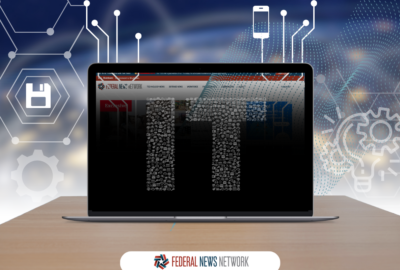Scientists are fighting wildfires with AI in the lab
"There is concern where we're scientists and we talk data, and that data in its raw form isn't particularly helpful to a first responder," Norman Spiecher said.
Can artificial intelligence help fight wildfires? That what a project inside Homeland Security seeks to find out. It’s known as WIFIRE. Researchers in the Homeland Security Science and Technology Directorate takes in loads of historical data. It feeds them into a model for guiding on-the-ground firefighters to where a fire might be headed. For more on the Federal Drive with Tom Temin, Federal News Network’s Eric White spoke to program manager Norman Spiecher.
Interview transcript:
Norman Spiecher So the WIFIRE Edge program represents a significant innovation, a move forward in terms of science and research. What they’re doing is taking baseline data that’s widely available. It varies from area to area, but largely that’s weather data, it’s topographical data, it’s things like fuel in the ground. So what the burn situation might look like. All kinds of satellite imagery and historic fire data. And then on top of that, we are distributing on scene fire sensors that collect things like barometric pressure, humidity, temperature, particulate matter. And so what this science is doing, what this research is doing is combining the baseline data with the data that’s being captured on site to then produce a fire prediction model that will be as accurate as possible and provide that feedback to first responders to understand more about the fire behavior, the potential fire behavior.
Eric White You call this the edge, and it doesn’t get closer to the edge than this. Do you actually have data analysts and data scientists setting up camp right next door to whatever the base camp is for the folks that are actually fighting the fire itself when these do occur.
Norman Spiecher So we do right now. There is this concern where we’re scientists and we talk data, and that data in its raw form is not particularly helpful to a first responder. We’ve got to synthesize that data and reapers and present that data in a meaningful manner. So that informs operational decision making. So yes, the moment, certainly UCSD, the University of California San Diego, the researchers in this particular effort are on scene and are looking at and very much sort of validating their modeling. So they’re getting feedback from the first responders where the models are being effective and providing that sort of predictive analysis. But the firefighters don’t need to look at the data. They don’t have to be data analysts. They don’t have to be fusion specialist. Really, what WIFIRE is ultimately supposed to do is present that fire modeling in a graphic user interface. So we happen in this instance to be using what’s called guts essentially to represent or to visually represent what that fire model looks like, and what the fire behavior is likely to how it’s likely to behave so that first responders don’t have to be data analysts to sort of glean an understanding of what to worry about and what not to worry about.
Eric White Looking at that model, it would probably be more important for the say war room folks to see it and so they can know where to deploy rather than somebody on the ground to go, Oh, the fire is actually moving three miles that way. It’s like, well, that’s great. It’s getting hot here, though, why don’t we get out of the way.
Norman Spiecher Yeah. You bring up a great point. And from my vantage point, I think there is historically models have been something that’s done in a back room. And it’s something that somebody comes in with a sheet of paper to, as you said, an operation center, an emergency operation center or something like that. And it’s sort of far removed from the actual responders. In this case, I think it’s important that incident scene is equally aware of that. When it shows its accuracy, ultimately shows its accuracy and the benefit of the on scene. Those back in the control room, those back in the ops centers are going going to have eyes on. But the intent is to push this data out so that there’s not that latency, that often has historically happened with fire modeling. And that is instantaneously or within minutes, we’re producing a real time forecast. It’s a little like the weather reports that you see that will show weather system over time, and how that weather system moves into the area, what area it’s likely to affect, etc., etc. That’s really what we’re trying to get to, is something that in a similar fashion makes a prediction of how that fire is going to behave.
Eric White We’re speaking with Norman Speicher. He is the program manager for the WIFIRE program at the Department of Homeland Security’s Science and Technology Directorate. Where did fire prediction stand before this tool? And I guess currently, since it’s still in the early stages being implemented, how good are the experts. Well, maybe they were utilizing some data, but how good is the latest and greatest on actually predicting where a wildfire is going to turn next.
Norman Spiecher It is showing a very much improved benefit in terms of first responders on scene. So historically, as we sort of discussed, it was really based on semi static data. So earth observation, satellite data, things like that that are not updated with a regular, at an interval that perhaps it needs to be for somebody on scene to react. And what WIFIRE Edge is doing is incorporating localized sensors. So again, to sort of draw an analogy with weather sensors, if you’ve got weather sensors over a broad area that may not necessarily represent what’s happening at your particular location. And with these localized sensors that are on body, they’re also on fire apparatus. We’re getting localized information that changes in real time. It reflects the real time situation. So what we’ve seen is a great increase in accuracy given that overlay of localized data. So what was perhaps very rife with latency in the past, we’re seeing real time representation that is accurate, and will ultimately in for better inform operational decision making.
Eric White Can you just talk a little bit about the tools that are actually providing that latency? Because as you get a lot of data, it takes a while to process and analyze it. How are you ensuring that you get that data, and right away it’s making decisions and showing you what you what the first responders actually need to see.
Norman Spiecher It’s exactly what the WIFIRE edge program is all about, showing that, as you said, a sizable amount of data can be synthesized onsite. So right now it’s a prototype. It’s not a scaled out system using chips that are designed for AI intensive processing. However, it is still showing and validating that we are headed in the right direction. That, yes, we can produce modeling in real time to take what in the past was perhaps a multi-hour process, and crunching it down to be several minutes at its worst. And we can only, it’s a reflection that processing power obviously is increasing at an exorbitant rate. And AI is pushing that to even a greater extent. So every indication currently is that computing power will not be the issue, that we’ll be able to ramp up and provide the computing power at the edge to ensure that no matter the amount of data or the size of the wildfire, we’ll be able to scale up that processing on site so that we can continue to produce real time fire modeling.
Eric White Yeah, that’s a good segue into my next question of where this is all going. Are we going to see fire departments that have certain personnel that are also trained in data science, or are there going to be data scientists teams that are deployed or on call just in case a wildfire does break out and it’s large enough that first responders need to get a grip on what it’s doing and how it might behave.
Norman Spiecher Where we hope that this is going, it’s not to necessitate first responder agencies have to create a new discipline of data analyst. We hope that where this heads is that increasingly fire sensors are deployed out in wildland urban interface areas and forested areas, etc., etc. We’re not there yet, but I believe that S&T see the future being that increasingly weather sensors, environmental sensors are deployed, broadly speaking, across large swaths of wildland areas, wildland urban interface areas, such that we can readily get this localized data. I think in the short term we’ll continue to leverage an aspect of this particular project which is deploying those sensors on the local responders. So everyone who deploys theoretically would have an on body sensor, all the fire apparatus, and all the personnel involved with deploy with a fire sensor. We’re not there yet, that wildland fire sensor manufacturers aren’t producing at scale, but we have multiple efforts that show the benefit and show the likelihood that localized data can greatly enhance the fire response and the operational decision making as the fire progresses.
Copyright © 2025 Federal News Network. All rights reserved. This website is not intended for users located within the European Economic Area.
Eric White is news anchor and Federal Drive producer at Federal News Network.
Follow @FEDERALNEWSCAST






